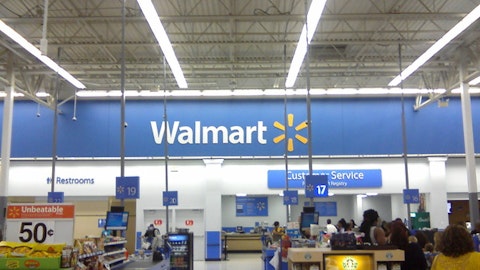In this article, we discuss the 5 boring stocks that make money. If you want to read our detailed analysis of these stocks, go directly to the 10 Boring Stocks That Make Money.
5. Lowe’s Companies, Inc. (NYSE:LOW)
Number of Hedge Fund Holders: 63
Dividend Yield: 1.56%
Trailing P/E: 21.63
Forward P/E: 16.95
Lowe’s Companies, Inc. (NYSE:LOW) is a home improvement retailer based in North Carolina that ranks fifth on the list of 10 boring stocks that make money. Although the company offers a dividend yield of only nearly 2%, Lowe’s Companies, Inc. (NYSE:LOW) is one of the cyclical stocks that returned to investors consistently through earnings and dividends. The company currently has a payout ratio of 26.78% and an average dividend per share growth rate of 13.68% in the last five years.
On August 18, Lowe’s Companies, Inc. (NYSE:LOW) has gained 10.2% solid earnings report. In the second quarter of 2021, Lowe’s Companies, Inc. (NYSE:LOW) reported an EPS of $4.25, beating estimates by $0.24. The company’s revenue in the second quarter climbed 2% year over year to $27.6 billion and beat revenue estimates by $811.43 million.
On September 17, UBS analyst Michael Lasser maintained a Buy rating on Lowe’s Companies, Inc. (NYSE:LOW) with a price target of $250 per share. According to the analyst, Lowe’s Companies, Inc. (NYSE:LOW) should be able to deliver balanced EPS growth in 2022, as the retailer manages labor expenses and repurchases over $9 billion in stock.
At the end of the second quarter of 2021, 63 hedge funds in the database of Insider Monkey held stakes worth $4.96 billion in Lowe’s Companies, Inc. (NYSE:LOW), up from 61 in the previous quarter worth $5.17 billion.
In the Q2 2021 investor letter of Pershing Square Holdings, Ltd., the fund mentioned Lowe’s Companies, Inc. (NYSE: LOW) and discussed its stance on the firm. Here is what the fund said:
“Since the onset of the COVID-19 pandemic, Lowe’s has experienced a significant acceleration in demand driven by consumers nesting at home, higher home asset utilization, and the reallocation of discretionary spend. In the three years since Marvin Ellison became CEO, the company has executed a multi-year transformation plan to bolster Lowe’s retail fundamentals, reduce structural costs, expand distribution capabilities, and modernize systems and the company’s online capabilities. This transformation has allowed Lowe’s to meet consumers’ needs during this highly elevated period of demand, and positioned the company for continued success and accelerated earnings growth.
In the second quarter, Lowe’s reported U.S. same-store-sales growth of 2.2%. Growth was bolstered by strength from the critical Pro-consumer, where Lowe’s reported growth of 21%, offsetting moderating do-it-yourself (“DIY”) demand. While DIY demand has receded from peak-COVID-19 periods, Pro customer demand has accelerated as consumers engage Pro’s for larger renovation projects.
Notwithstanding the headline growth figure, which is impacted by comparisons to COVID-19-affected months from spring of 2020, demand remains extremely elevated relative to baseline 2019 levels. July same-store sales, the most recent full month for which the company has provided disclosure, were up 31.5% on a two-year basis and management indicated August month-to-date results are substantially similar. More significantly, Lowe’s reported Pro growth of +49% on a two-year basis in Q2, evidence that Lowe’s focus on the Pro is bearing fruit. Share gains with the critical Pro customer will provide a tailwind to growth that should allow Lowe’s to outperform market-level growth going forward.
Even as the robust demand experienced during the height of COVID-19 stabilizes at a new base, the medium and longer-term macro environment remain very attractive for the home improvement sector and Lowe’s in particular. This favorable context for the sector is evidenced by consumers’ enhanced focus and appreciation of the importance of the home, higher home asset utilization, rising home prices, historically low mortgage rates, an aging housing stock, strong consumer balance sheets, and the general lack of new housing inventory.
Against this backdrop, Lowe’s is focused on taking market share and expanding margins. Pro penetration today is still only 25% of revenue as compared to Lowe’s medium-term target of 30% to 35%, providing a runway for continued above-market growth. Management continues to execute against various operational initiatives (Lowe’s “Perpetual Productivity Improvement” program) designed to improve the customer experience while enhancing the company’s margins and long-term earnings power. The company’s long-term outlook implies a significant opportunity for continued margin expansion and earnings appreciation as it executes its business transformation.
Lowe’s currently trades at approximately 17 times forward earnings. Home Depot, its closest competitor, trades at approximately 22 times forward earnings despite Lowe’s superior prospective earnings growth. We find this valuation disparity to be anomalous in light of Lowe’s strong execution and potential for further operational optimization.”





